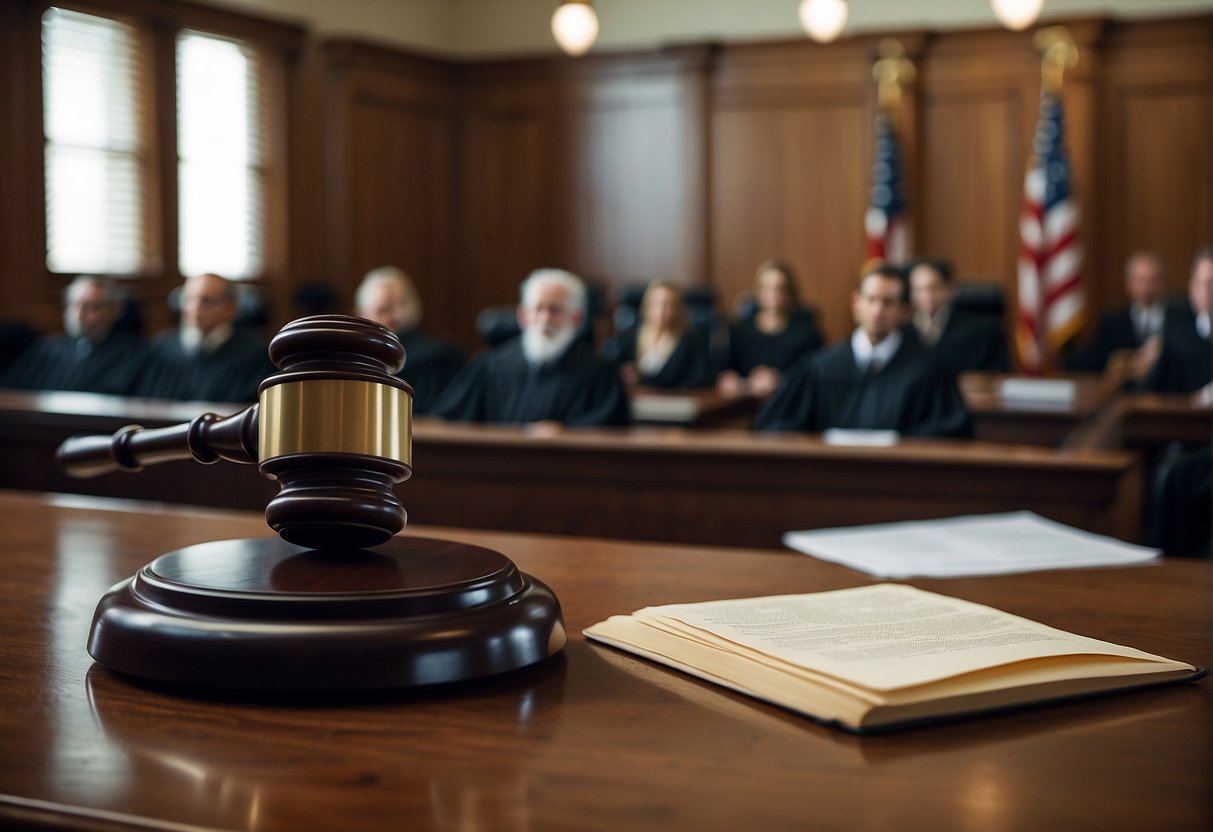Understanding the Basics

Navigating the labyrinth of a personal injury lawsuit begins long before stepping foot in the courtroom. The trial process is a structured journey, from the careful selection of representation to the crucial exchange of legal pleadings.
Initial Consultation and Attorney Selection
At the outset, selecting the right personal injury attorney is crucial; it’s the foundation upon which your case’s success is built. During the initial consultation, we will assess the details of the accident to determine the viability of your personal injury case. It’s our duty to ensure that we choose the appropriate jurisdiction and venue for filing the lawsuit, as they can greatly affect the case’s progress and outcome.
Filing the Complaint and Serving the Defendant
Once we decide to proceed, the complaint is meticulously drafted—this is the formal declaration of your lawsuit, outlining the injuries and asserting claims against the defendant. After filing the complaint, we must deliver a summons and the complaint to the defendant, a process known as serving the defendant, to officially notify them of the pending legal action.
Responses and Pleadings from Both Parties
Upon receiving the summons, the defendant is compelled to submit an answer within a predetermined timeframe, contesting or acknowledging the claims made against them. This exchange of pleadings sets the stage for the ensuing legal battle, as both plaintiff and defendant lay out their positions, and we fortify ours, readying for the subsequent phases of the personal injury lawsuit.
Pre-Trial Conferences and Motions
Before a personal injury case proceeds to trial, we engage in several crucial steps that pave the way for either a settlement or a presentation before a jury. These include discovery processes, settlement negotiations, as well as various motions and hearings.
The Discovery Process
During the discovery phase, parties exchange essential information pertinent to the case. This includes depositions and interrogatories, where we gather testimonies and written responses from all involved parties. We meticulously review documentation, such as medical records and bills, to piece together a comprehensive understanding of the circumstances and evidence. Knowledge gained here fuels our strategy, whether for settlement or trial.
Mediation and Settlement Negotiations
Mediation and settlement negotiations are critical pathways to resolving a case before it reaches court. We engage with the insurance company and the defense attorney in negotiations where we advocate for a fair settlement that accurately addresses the damages incurred. Our role is to ensure that the resolution is commensurate with your losses, whether through mediated agreements or direct discussions.
Motions and Hearings
Throughout the pre-trial stage, we may file motions to resolve legal disputes or clarify jurisdictional issues. Hearings allow us to present these motions before a judge, seeking decisions on the admissibility of evidence or to compel the other party to release information. This is a tactical process to either narrow the focus of the upcoming trial or, at times, conclude the litigation favorably without the need for a trial.
Trial Proceedings

In a personal injury lawsuit, the trial proceedings are a critical stage where both sides present their evidence to a jury. This process is the culmination of pre-trial preparations and is structured into specific phases to ensure a fair and lawful evaluation of the case.
Jury Selection and Trial Begins
Jury Selection: We begin the trial proceedings by selecting a jury, a process known as voir dire. During this phase, potential jurors are questioned to ensure they can be impartial. Only those free from bias will hear the case and ultimately render a verdict.
Trial Begins: Once the jury is selected, the trial officially begins. Opening statements are made by both the plaintiff’s and defendant’s legal teams to outline their case to the jury. This is the first opportunity for us to present the overall narrative and set the stage for the evidence that will unfold.
Presentation of Evidence and Witness Testimony
Presentation of Evidence: Throughout the trial, we methodically present evidence to build our argument. The evidence could include physical items, documents, or photographs relevant to the case. It’s essential to establish the facts and context for the jury clearly.
Witness Testimony: We call upon witnesses to provide their accounts of the situation under oath. This testimony can include witness observations, expert insights, and cross-examination to challenge their credibility or understanding of the facts. The strength of a witness’s testimony can greatly impact the jury’s perception of the case.
Closing Arguments and Jury Deliberation
Closing Arguments: After all evidence is presented and witness testimonies are heard, we make closing arguments. These arguments are our last chance to synthesize the case presented and persuade the jury of our client’s position.
Jury Deliberation and Verdict: Upon receiving jury instructions from the judge, the jury deliberates privately. They assess the evidence and testimony to reach a fair verdict. The culmination of the trial is the announcement of this verdict, which determines if the defendant is liable and, if so, the compensation to be awarded to the plaintiff. If we are successful, the judge will enter a judgment in favor of our client.
After Trial: Verdict and Appeals

Following a personal injury trial, we move into the critical phases where the verdict is determined and the potential for an appeal is considered. We’ll guide you through understanding how a verdict can lead to a judgment and explore the post-trial motions and appeal options available to the parties involved.
Reaching a Verdict and Potential Judgment
A verdict is reached after all evidence is presented, and either a judge or jury deliberates to decide if the defendant is liable for the plaintiff’s injuries. Liability is mainly determined on the basis of negligence or fault. Upon reaching a verdict, if the defendant is found liable, a judgment will be issued outlining the compensation for damages to be paid to the plaintiff. The compensation could cover medical expenses, lost wages, and other losses stemming from the injury. It’s at this stage that insurance companies often become highly involved, particularly if a personal injury settlement is being discussed.
Post-Trial Motions and Appeal Options
After the verdict, either party may file post-trial motions. These can include a motion for a new trial or a motion to alter or amend the judgment. Such motions are typically filed if there are substantial reasons to believe that legal errors were made that could have affected the outcome of the trial.
If post-trial motions are not successful or are not pursued, a party may consider filing an appeal. The appeals process involves a higher court reviewing the trial’s proceedings to determine whether legal procedures and laws were correctly applied. Appealing a personal injury verdict is a serious consideration as it can be expensive and time-consuming, and it delays the final resolution and any potential settlement payout.
During the appeal, the appealing party, known as the appellant, typically presents an appellate brief, arguing why the verdict should be reversed or modified. The other party can also submit a brief to counter these arguments. It’s essential to know that an appeal is not a re-trial of the case but rather a review of the application of the law.
In some cases, instead of immediately paying the damages awarded, the defendant may opt for arbitration or a negotiated settlement to avoid the appeal process. Settlement at this stage might be preferable for both sides to avoid further legal expenses and to bring about a resolution more quickly.
Damage Recovery and Case Closure
After a personal injury trial concludes, we turn our attention to damage recovery and case closure. This step is a crucial phase, where the successful plaintiff recovers compensation awarded by the court. The compensation aims to cover medical expenses, lost wages, and pain and suffering experienced due to the incident. It’s important to understand the types of damages for which one may receive reimbursement:
- Economic Damages: Tangible losses such as medical bills and lost income.
- Non-Economic Damages: Intangible losses like pain and suffering and emotional distress.
In cases of medical malpractice, compensation might additionally cover longer-term care or therapy. The at-fault party, often represented by an insurance company, is usually responsible for paying the awarded amount. Here’s a straightforward list of possible recovery steps:
- Judgment Issuing: A formal court decision is made.
- Collection Process: Begins if the defendant does not voluntarily pay.
- Negotiation with Insurance Companies: Sometimes involves further discussion regarding settlement amounts.
- Potential Liens: Handled if healthcare providers seek payment from the settlement for services rendered.
Our fee agreement, often on a contingency basis, ensures legal fees align with the recovered damages. If awarded damages are not paid voluntarily, we may need to take additional steps, like garnishment or liens, to collect.
It’s essential to recognize that each **personal injury claim **is unique, and the recovery process may vary based on jurisdiction, whether it’s a small claims court, federal court, or a typical civil court dealing with civil cases or civil lawsuits. Rest assured, we persistently pursue the closure of our client’s case, ensuring all legal avenues are explored for the recovery of due compensation.




